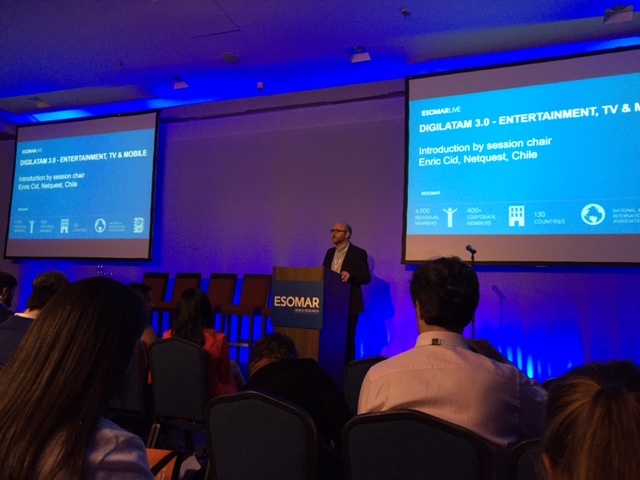During the last 6 months, I have been honoured to be a member of the Programme Committee for the 2016 edition of theESOMAR Latin America Conference that was held in Bogota (Colombia), last 10th -12th April.
ESOMAR’s events are always a great opportunity to gauge the market research industry and better understand the main challenges it is facing. This Latin America gathering with 20 selected papers to be presented and more than 200 delegates attending was no exception.
It is well known that the market research industry has been at a crossroads for a few years now, an identity crisis. Two main forces have apparently torn market researcher’s toolbox apart:
- The digital world produced an explosion of consumer data: consumer opinions were “already there” so market research was no longer needed to collect them by doing surveys or using focus groups. With that amount of “opinion” available, clients wanted more than just data from market research companies. Data alone had become commoditized and prices fell.
- The digital world changed consumers’ mindsets too: market research surveys were no longer appealing to “make their voice heard”, consumers had blogs, Twitter, Facebook and an infinite number of web sites to make suggestions, send feedback or even complain more effectively. So market research response rates dropped down, and collecting opinions through the traditional toolbox was harder than ever.
In Latin America, this deep transformation came overnight, in the period of no more than 4 years, - which made it even more difficult to assimilate and overcome. Fortunately, it is clear for market research practitioners today that, even though they have to stretch their skill sets, there still is value in it. There is no need for researchers to become business consultants, and yes, there still is need to collect data and make sense of it. Now, we can understand market research as three interlocked layers where data is the core element:
- Collect data:
Certainly, there is an explosion of consumer data sources: from internal CRM systems to social media opinions, from cell phone GPS location to web navigation tracking, - you name it. However, there still is a need to collect and store all these data in a structured way that makes it accessible and manageable (this IT capability is a compulsory addition to market researcher’s toolbox). Partnering with data owners, and most importantly, producing data that fill the gap between these data sources is pivotal for market researchers. For instance, although you might keep track of GPS connections of all the devices in a particular region, you might need to know the demographic information of those devices (those people) in order to construct out-home advertising exposure. Usually, filling these gaps means gathering consumer-centric information, so the ability to engage with “digital” consumers and obtain this information directly from them is another important element to add to the toolbox.
- Make sense of data:
Once you have access to several sources of data and it is clearly structured and tagged, you need to make sense of it. To do so, researchers need to merge, calibrate, weigh up, triangulate between those data sources (as seen in the GPS example above). Understanding data source capabilities and limitations - potential biases - is key. This is also where conceptual frameworks from a number of disciplines (mathematics, statistics, neurology, psychology, sociology, etc.) come to the rescue. How important are those trends gathered from social media? How can I reduce dimensions from a certain list of correlated consumer variables? What kind of information can I obtain from recordings of people's faces while watching commercials? Making data “understandable” is the next step.
- Make data actionable:
The final output. At the end of the day, companies invest in market research to reduce risk in their decision-making. That “action” could be Netflix producing a new TV show hit, creating a model to predict churn form their subscription base and implementing retention offers, or planning expansion into new markets based on trends of consumer behavior and setting budgets according to it. Make data “actionable” to make data relevant. Savvy researchers, usually in-company researchers, are the best positioned to add the business context needed to make this final step happen.
In conclusion, market research might have been at a crossroads for a while but its future path is clear now. Moreover, although it certainly has to add specific tools from other disciplines, the path that it has to follow does not differ greatly from where it was coming from. Nevertheless, as we saw in the ESOMAR Latam Conference, there are more variables in the equation. To succeed market research must increase its pace, gain velocity.
Need for speed.
In all forms of human activities there is a trade-off between speed and accuracy; accuracy means testing and control, at the expense of speed. For market research, reliability is the cornerstone, so increasing speed is a particularly difficult challenge. However, not a single presentation in Bogota undermined the importance of urgency in what market research does. On the contrary, the world turns faster than ever today and last month’s data is completely obsolete, so data must be fast or will not be relevant at all.
As part of the 2016 Latin America Programme Committee, we had the responsibility, -and privilege-, to nominate one paper from the regional conference for the ESOMAR Excellence Award for Best Paper, -which carries a grand-prize of € 4,000 and will be presented at ESOMAR's annual Congress held in New Orleans in September this year.
We unanimously selected an outstanding paper, “Coca-Cola Culture Club, Exploring Brand Execution in Point of Sale” by Gabriel Neira, from Dichter & Neira, and Jorge Fonseca, from Coca-Cola, which is an excellent example of what we were saying:
- Changing a traditional store audit supervision model based on human follow-up to a technological (geo-references, digital maps, pictures) and transparent process that generates more reliable information. (Collect data)
- Processing data and generating KPI visualization reports accessible from any device with a web browser in real time. Reports are tailored for the specific needs and responsibilities of each decision-maker. (Make sense of data)
- Creating tools to correlate execution KPIs with business variables in order to identify new opportunities and define winning strategies. (Make data actionable)
Collecting data in innovate ways, making sense of it and making it relevant, at a very fast pace; that is the road that leads the market research industry back to unlocking great value. Savvy market research players that resolve the trade-off between reliability and speed will find the way back to strong growth.
Exciting days are coming.






